Answer the following :
In Fig.6.13. (i) the man walks 2m carrying a mass of 15kg on his hands. In Fig. 6.13. (ii), he walks the same distance pulling the rope behind him. The rope goes over a pulley, and a mass of 15 kg hangs at its other end. In which case is the work done greater?
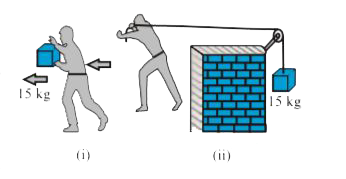
In the second case.
Topper's Solved these Questions
- WORK, ENERGY AND POWERBOOK - NCERT TELUGUCHAPTER - WORK, ENERGY AND POWEREXERCISE - EXERCISES (ADDITIONAL EXERCISES)
6 Videos
- WORK, ENERGY AND POWERBOOK - NCERT TELUGUCHAPTER - WORK, ENERGY AND POWEREXERCISE - EXERCISES (ADDITIONAL EXERCISES)
6 Videos
- WAVESBOOK - NCERT TELUGUCHAPTER - WAVESEXERCISE - Exercises
21 Videos
Similar Questions
Answer the following:
a) The casing of a rocket in flight burns up due to friction. At whose expense is the heat required for burning obtained? The rocket or the atmosphere?
b) Comets move around the sun in highly elliptical orbits. The gravitational force on the comet due to the sun is not normal to the comet's velocity in general. Yet the work done by the gravitatonal force over every complete orbit of the comet is zero. Why?
c) An artificial satellite orbiting the earth in very atmosphere loses its energy grdually due to dissipation against atmospheric resistance, howerver small. Why then does its speed increase progressively as it comes closer and closer tothe earth? d)In fig i) the man walks 2m carrying a mass of 15 kg on his hands. In Fig ii) he walks the same distance pulling the rope behind him. The rope goes over pulley, and a mass of 15 kg hangs at its other end. In which case is the work done greater?
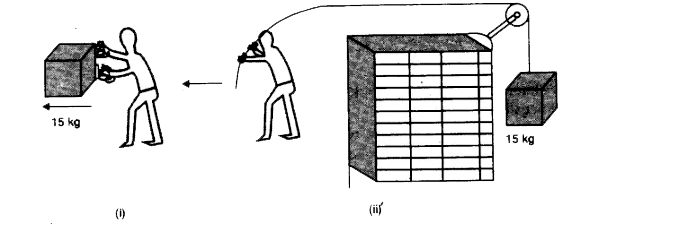
View SolutionAnswer the following:
a) The casing of a rocket in flight burns up due to friction. At whose expense is the heat required for burning obtained? The rocket or the atmosphere?
b) Comets move around the sun in highly elliptical orbits. The gravitational force on the comet due to the sun is not normal to the comet's velocity in general. Yet the work done by the gravitatonal force over every complete orbit of the comet is zero. Why?
c) An artificial satellite orbiting the earth in very atmosphere loses its energy grdually due to dissipation against atmospheric resistance, howerver small. Why then does its speed increase progressively as it comes closer and closer tothe earth? d)In fig i) the man walks 2m carrying a mass of 15 kg on his hands. In Fig ii) he walks the same distance pulling the rope behind him. The rope goes over pulley, and a mass of 15 kg hangs at its other end. In which case is the work done greater?

View Solution
Knowledge Check
A man of mass m stands on a frame of mass M. He pulls on a light rope, which passes over a pulley. The other end of the rope is attached to the frame. For the system to be in equilibrium, what force must the man exert on the rope?
 A(M+m)g2B(M+m)gC(M−m)gD(M+2m)g
A(M+m)g2B(M+m)gC(M−m)gD(M+2m)gA block of mass M is tied to one end of a massless rope the other end of the rope is in the hands of a man of mass 2M as shown in the figure the block and the man are resting on a rough plank of mass M as shown in the figure the whole system is resting on a smooth horizontal surface the man pulls the rope pulley is massless and friction what is the displacement of the plank when the block meets the pulley ( Man does not leave his position on plank during the pull)
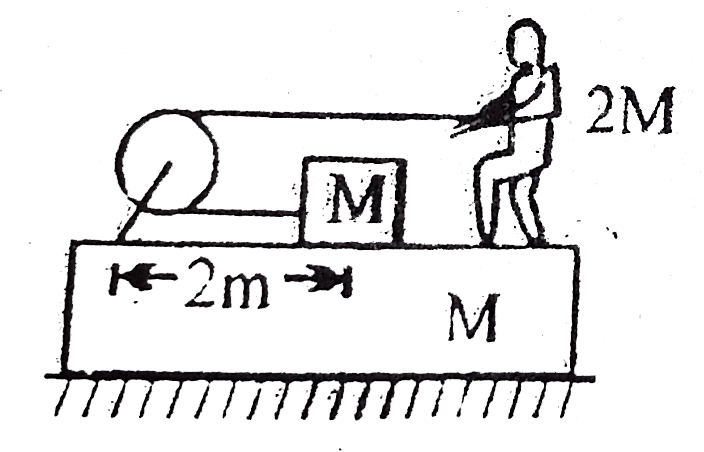 A0.5mB1mCzeroD2/3m
A0.5mB1mCzeroD2/3m
A man of mass m stands on a frame of mass M. He pulls on a light rope, which passes over a pulley. The other end of the rope is attached to the frame. For the system to be in equilibrium, what force must the man exert on the rope?

View SolutionThe pulley arrangements of Figs. (a) and (b) are identical. The mass of the rope is negligible. In (a) the mass m is lifted up by attaching a mass 2m to the other end of the rope. In (b), m is lifted up by pulling the other end of the rope with a constant downward force F=2mg. The acceleration of m is the same in both cases

View SolutionThe pulley arrangements of Figs. (a) and (b) are identical. The mass of the rope is negligible. In (a) the mass m is lifted up by attaching a mass 2m to the other end of the rope. In (b), m is lifted up by pulling the other end of the rope with a constant downward force F=2mg. The acceleration of m is the same in both cases

View SolutionA uniform rope of linear mass density λ (kg/m) passes over a smooth pulley of negligible dimension. At one end B of the rope there is a small particle having mass one fifty of the rope. Initially the system is held at rest with length L of the rope on one side and length L4 on the other side of the pulley (see fig). The external agent begins to pull the end A downward. Find the minimum work that the agent must perform so that the small particle will definitely reach the pulley.
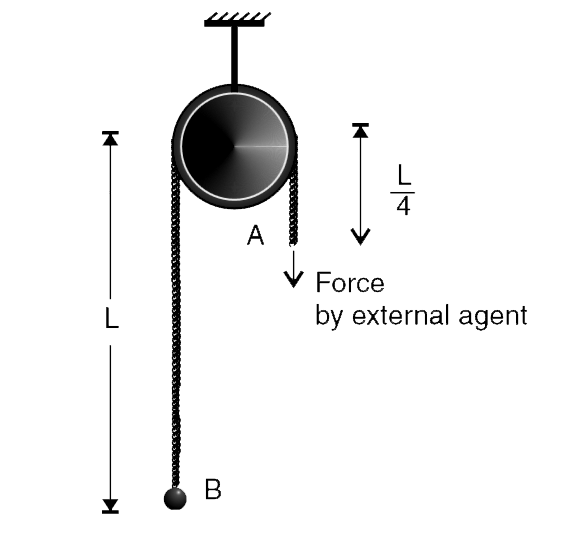
View Solutionshows a man of mass 60 kg standing on a light weighing machine kept in a cabin of mass 40 kg The cabin is hanging from a pulley fixed to the ceiling through a light rope, the other end of which is held by the man himself if the man manages to keep the cabin at rest, what is the weight shown by the machine? What force should he exert on the rope to get his correct weight on the machine?
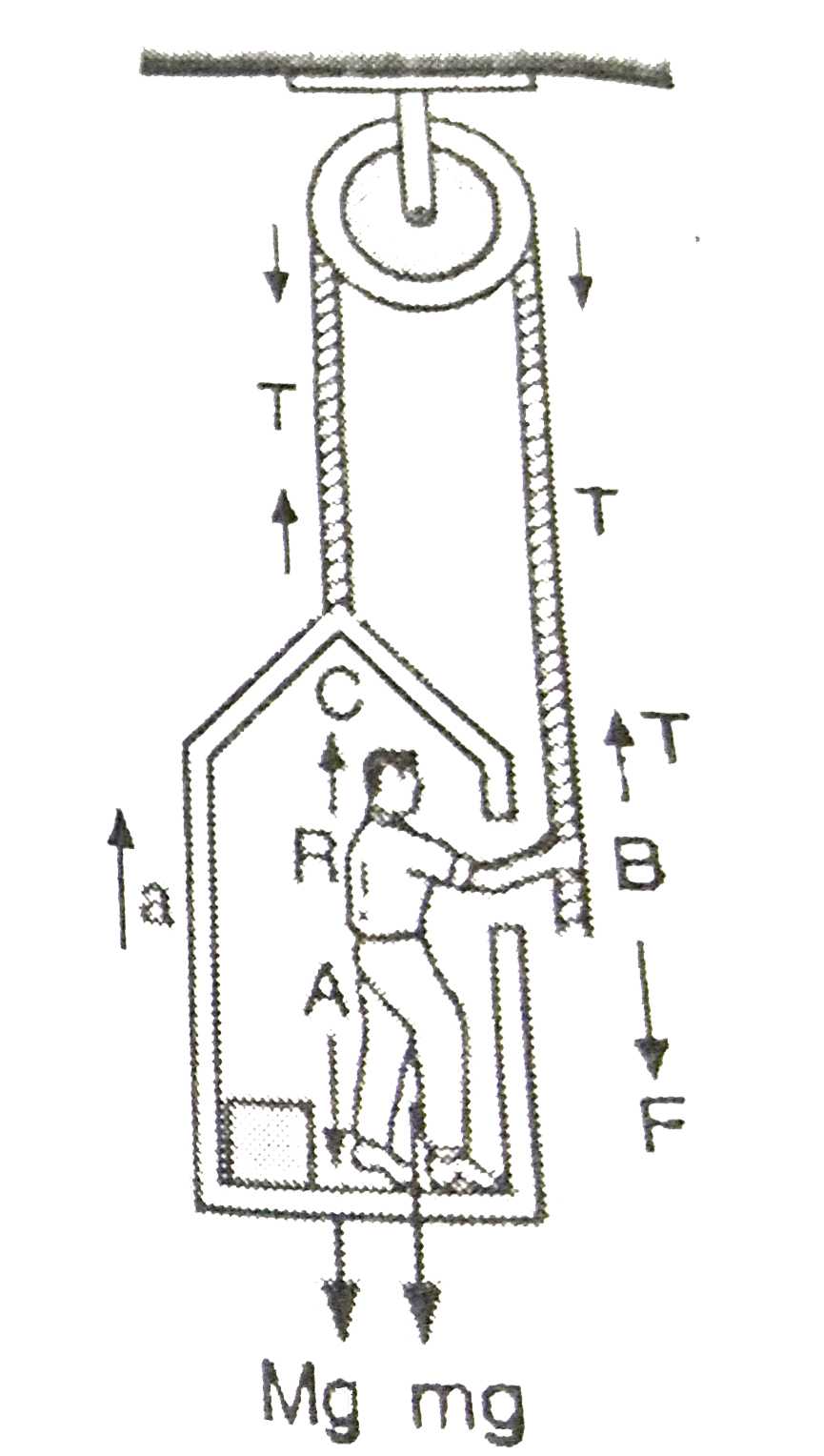
View SolutionA uniform rope of length 12m and having a mass 6kg hangs" vertically froma rigid support. A block of mass. 2kg is attached to the free end of rope. A transverse pulse of wavelength 0.06m is prođuced at the lower end of rope. Its wavelength when it reeches the top end of the rope is given by αm. Find 50α.
View Solution
